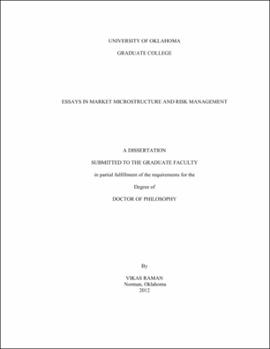| dc.description.abstract | This dissertation is a collection of three essays that investigates various issues related to market microstructure and risk management. Chapter 1 examines the determinants of traders' decisions to revise orders, and the profitability of traders' order revision strategies using a unique dataset which provides complete information on trades, orders, trader identification codes, and trader categories. The analysis provides three important results. One, informed traders and traders who function as voluntary market makers revise orders most intensely. Two, along with changes in market prices and other market conditions, changes in traders' inventories, including inventories of correlated stocks, influence order revision strategies. Three, informed traders reduce the execution costs of their order portfolios through active order revisions; the benefit is especially pronounced on earnings announcement days, when the value of private information is high. That traders employ revisions to mitigate their order submission, inventory, and adverse selection risks indicates that order revisions are a valuable feature of the rapidly proliferating electronic limit order markets. Chapter 2 examines the impact of the option to fail and the resultant naked short-selling on market quality. For a sample of 1,492 NYSE securities, the study finds that naked short-selling has the same beneficial impact on liquidity and pricing efficiency as covered short-selling. The study does not find any evidence that naked short-sellers engineered price declines or distortions, or triggered the demise of financial firms during the 2008 financial crisis. Hence, the study questions the removal of the option to fail, a potentially valuable tool for limiting settlement-related distortions and stock-borrowing costs of all short-sellers. Chapter 3 examines how the gold and stock markets react to corporate hedging announcements by gold mining firms. The gold market reaction is consistent with the market believing that firms have credible private information about future gold prices, which is puzzling in light of extant evidence that firms cannot successfully time the market when they hedge. After controlling for the gold market announcement effect, the study finds a strong negative (positive) reaction in the stock prices of the firm making the announcement and other gold mining firms to a hedging increase (decrease), suggesting that (a) the announcement also conveys information about a change in the expected cost of financial distress of both the firm and its industry; and (b) any shareholder benefit of a hedging increase is more than offset by the negative news conveyed to shareholders about the change in the firm's prospects, and vice versa. These findings provide new insights into the endogeneity associated with hedging policy changes and its confounding effect on measuring the relation between hedging and the value of the firm. | |
